
Light pollution is the presence of any unwanted, inappropriate, or excessive artificial lighting. In a descriptive sense, the term light pollution refers to the effects of any poorly implemented lighting sources, during the day or night. Light pollution can be understood not only as a phenomenon resulting from a specific source or kind of pollution, but also as a contributor to the wider, collective impact of various sources of pollution.
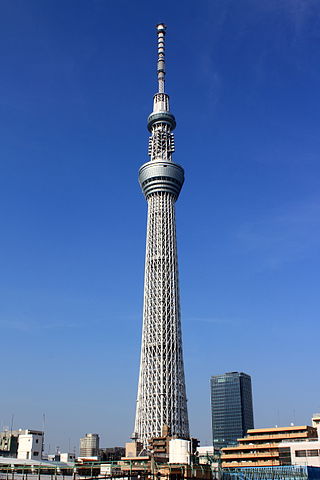
A tower is a tall structure, taller than it is wide, often by a significant factor. Towers are distinguished from masts by their lack of guy-wires and are therefore, along with tall buildings, self-supporting structures.
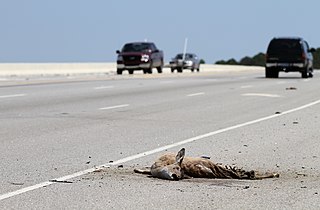
Roadkill is a wild animal that has been killed by collision with motor vehicles. Wildlife-vehicle collisions (WVC) have increasingly been the topic of academic research to understand the causes, and how they can be mitigated.
Aviation is the design, development, production, operation, and use of aircraft, especially heavier-than-air aircraft. Articles related to aviation include:

A bird strike is a collision between an airborne animal and a moving vehicle. The term is also used for bird deaths resulting from collisions with structures, such as power lines, towers and wind turbines.

Radio masts and towers are typically tall structures designed to support antennas for telecommunications and broadcasting, including television. There are two main types: guyed and self-supporting structures. They are among the tallest human-made structures. Masts are often named after the broadcasting organizations that originally built them or currently use them.

Aviation obstruction lighting is used to enhance the visibility of structures or fixed obstacles which may conflict with the safe navigation of aircraft. Obstruction lighting is commonly installed on towers, buildings, and even fences located in areas where aircraft may be operating at low altitudes. In certain areas, some aviation regulators mandate the installation, operation, color, and/or status notification of obstruction lighting. For maximum visibility and collision-avoidance, these lighting systems commonly employ one or more high-intensity strobe or LED devices which can be seen by pilots from many miles away from the obstruction.
Sensory ecology is a relatively new field focusing on the information organisms obtain about their environment. It includes questions of what information is obtained, how it is obtained, and why the information is useful to the organism.

Bird conservation is a field in the science of conservation biology related to threatened birds. Humans have had a profound effect on many bird species. Over one hundred species have gone extinct in historical times, although the most dramatic human-caused extinctions occurred in the Pacific Ocean as humans colonised the islands of Melanesia, Polynesia and Micronesia, during which an estimated 750–1,800 species of birds became extinct. According to Worldwatch Institute, many bird populations are currently declining worldwide, with 1,200 species facing extinction in the next century. The biggest cited reason surrounds habitat loss. Other threats include overhunting, accidental mortality due to structural collisions, long-line fishing bycatch, pollution, competition and predation by pet cats, oil spills and pesticide use and climate change. Governments, along with numerous conservation charities, work to protect birds in various ways, including legislation, preserving and restoring bird habitat, and establishing captive populations for reintroductions.

H5N1 influenza virus is a type of influenza A virus which mostly infects birds. H5N1 flu is a concern due to the fact that its global spread may constitute a pandemic threat. The yardstick for human mortality from H5N1 is the case-fatality rate (CFR); the ratio of the number of confirmed human deaths resulting from infection of H5N1 to the number of those confirmed cases of infection with the virus. For example, if there are 100 confirmed cases of a disease and 50 die as a consequence, then the CFR is 50%. The case fatality rate does not take into account cases of a disease which are unconfirmed or undiagnosed, perhaps because symptoms were mild and unremarkable or because of a lack of diagnostic facilities. The Infection Fatality Rate (IFR) is adjusted to allow for undiagnosed cases.
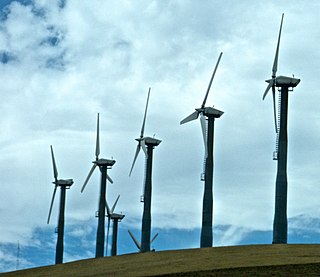
The Altamont Pass wind farm is located in the Altamont Pass of the Diablo Range in Northern California. It is one of the earliest wind farms in the United States. The first wind turbines were placed on the Altamont in the early 1980s by Fayette Manufacturing Corporation, on land owned by cattle rancher Joe Jess. The wind farm is composed of 4,930 relatively small wind turbines of various types, making it at one time the largest wind farm in the world in terms of capacity.

Bird–window collisions are a problem in both low- and high-density areas worldwide. Birds strike glass because reflective or transparent glass is often invisible to them. It is estimated that between 100 million and 1 billion birds are killed by collisions in the United States annually, and an estimated 16 to 42 million birds are likewise killed each year in Canada.

The environmental impact of electricity generation from wind power is minor when compared to that of fossil fuel power. Wind turbines have some of the lowest global warming potential per unit of electricity generated: far less greenhouse gas is emitted than for the average unit of electricity, so wind power helps limit climate change. Wind power consumes no fuel, and emits no air pollution, unlike fossil fuel power sources. The energy consumed to manufacture and transport the materials used to build a wind power plant is equal to the new energy produced by the plant within a few months.
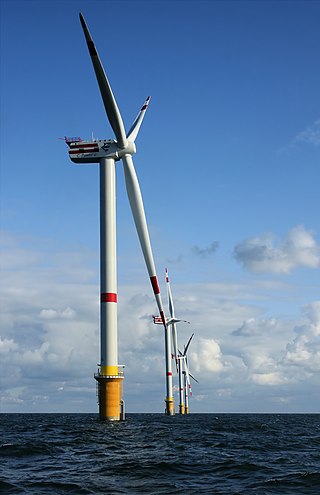
A wind turbine is a device that converts the kinetic energy of wind into electrical energy. As of 2020, hundreds of thousands of large turbines, in installations known as wind farms, were generating over 650 gigawatts of power, with 60 GW added each year. Wind turbines are an increasingly important source of intermittent renewable energy, and are used in many countries to lower energy costs and reduce reliance on fossil fuels. One study claimed that, as of 2009, wind had the "lowest relative greenhouse gas emissions, the least water consumption demands and the most favorable social impacts" compared to photovoltaic, hydro, geothermal, coal and gas energy sources.

Rosiere is an unincorporated community on the border of Kewaunee County and Door County in Wisconsin, in the towns of Lincoln, and Brussels.
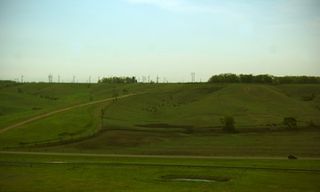
Buffalo Ridge Wind Farm is a large wind farm on Buffalo Ridge near Lake Benton, Minnesota, United States.

Raptor conservation concerns are threats affecting the population viability of birds of prey. Because of their hunting lifestyle, raptors face distinct conservation challenges. As top predators, they are important for healthy ecosystem functioning, and by protecting them many other species are safeguarded. Their extensive habitat requirements make regional conservation strategies necessary for protecting birds of prey.

Ecological light pollution is the effect of artificial light on individual organisms and on the structure of ecosystems as a whole.

Migrating birds face many perils as they travel between breeding and wintering grounds each year.

Light pollution is the presence of unwanted artificial light that brightens the night sky. Improperly shielded lights are the source of many of the issues regarding the light pollution in Hawai'i. Urban centers in the cities are often so bathed in light that over a hundred kilometers from the city's edge, the light pollution resulting from the glow is present. Fabio Falchi is quoted as stating that “light pollution is one of the most pervasive forms of environmental alteration” due to its destructive nature in both un- and protected areas such as national parks. Dark night skies are an important natural, cultural, scientific, educational, and economic resource for Hawai‘i.


















